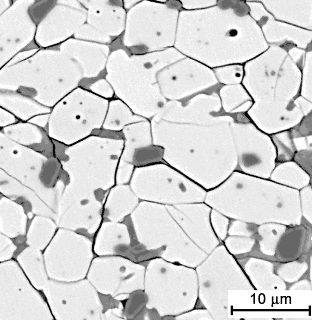3.4.2.5 Aluminium
Titanate
Aluminium titanate (ATI) ceramic is the stoichiometric
solid solution of aluminium oxide and titanium dioxide (Al2O3
. TiO2), and is distinguished by:
- low modulus of elasticity
- low thermal conductivity,
- very low coefficients of thermal expansion, leading to
excellent thermal shock resistance and to
- low wettability by molten non-ferrous metals
These properties result from a high a residual porosity and
from micro-cracks resulting from highly anisotropic thermal
expansion in the individual ATI crystals. These crystals display
very different coefficients of thermal expansion along their
three primary axes. In two directions it is positive, i.e.
there is an expansion as the temperature rises, but along
the third axis it is negative, generating a contraction. As
a result of this, during manufacture, and in particular during
cooling, tensions develop on a microscopic scale, the consequence
of which is the formation of micro-cracks in the microstructure.
In terms of the macroscopic expansion, due to the anisotropic
thermal expansion of the individual crystals, the material
yields a very low thermal expansion, since this initially
involves the micro-cracks; in other words, the cracks close.

Figure 18: Microstructure of an aluminium
titanate
The outstanding thermal shock resistance
of ATI results from the low coefficient of thermal expansion
on the macroscopic scale, in combination with the low modulus
of elasticity. The dependency of the strength and of the modulus
of elasticity on temperature also have what for ceramics are
unusual curves. Both values increase as the temperature rises,
effects that are again due to the closing of the micro-cracks
at higher temperatures. The low mechanical strength specific
to this material can be compensated for through composite
structures.
The material is used, for instance, in portliners,
cylinder liners and vehicle engines, in the spacing rings
of catalytic converters, as kiln furniture and in foundry
engineering. Here it is particularly found in aluminium smelting
works where it is used for rising pipes and proportioning
pipes, nozzles, crucibles, flow regulators and so forth.
|
|

